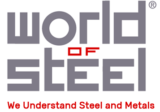Substrate for Tinplate
Substrate for tinplate
The steel base used for tinplate manufacture is a low carbon mild steel typically containing 0.003 – 0.12% carbon. This is now largely made by the basic oxygen steelmaking (B.O.S.) process. The basic oxygen process produces steel with low residuals and with good formability and mechanical properties.
The steels for tinplate use are almost exclusively made from slabs produced by continuous casting. The steel prior to casting is fully killed i.e. the excess oxygen from the steelmaking process is removed by the addition of an oxide former, usually aluminium.
The advantages of continuous casting over the previously used ingot route are the freedom from segregation and the internal cleanliness of the steel. This is of great importance for two piece can manufacture.
National and international specifications do not normally stipulate composition requirements. However, some standards such as ASTM A623 give a general guide to the types of steel most generally used. Table below outlines the chemical requirements for three steel types. It should be noted that the percentages quoted are maximal and normally the actual amounts are much lower, e.g. the carbon is frequently well below 0.10% C. The generalisation of continuous casting requires that steel formulation must be able to produce the highest steel qualities.
Table Chemical requirements from ASTM A623
|
Element |
Cast composition, max. % |
||
|
Type D |
Type L |
Type MR |
|
|
Carbon Manganese Phosphorus Sulphur SiliconA,B Copper Nickel Chromium Molybdenum AluminiumC Other elements, each |
0.12 0.60 0.020 0.03 0.020 0.20 0.02 |
0.13 0.60 0.015 0.03 0.020 0.06 0.02 |
0.13 0.60 0.020 0.03 0.020 0.20 0.02 |
- When steel produced by the silicon killed method is ordered, the silicon maximum may be increased to 0.080% .
- When strand cast steel produced by the aluminium killed method is ordered or furnished, the silicon maximum may be increased to 0.030% when approved by the purchaser.
- Types L and MR may be supplied as non-killed or killed which would respectively be produced without and with aluminium additions. Minimum aluminium level for type D is usually 0.02%
Chemical composition of the steel is important for corrosion resistance; in general, the more corrosive the pack, the tighter must be the control of some of the constituent elements in the steel. C omposition also has a great influence on formability of the steel.
The most commonly used steel is Type MR. This is low in metalloids and residual elements, and procures a good corrosion resistance.
Type D steel is a stabilised low carbon steel, used where extra deep drawing characteristics are required. Many steels suffer a deterioration in ductility on ageing after temper rolling; stabilised steels do not undergo this strain age hardening. This feature of ageing is used with benefit to produce steels hardening after forming: steel which has been renitrogenised for greater strength is available in types L and MR, being indicated by an “N” suffix, e.g. Type LN steel.
- Source: The International Tin Association (formerly ITRI Ltd)
